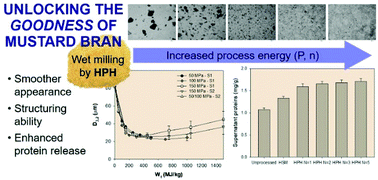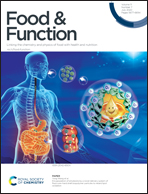Mechanical cell disruption of mustard bran suspensions for improved dispersion properties and protein release†
Abstract
Mustard bran, a by-product of mustard production, is still rich in valuable compounds. The high-pressure homogenization treatment was tested as a mechanical cell disruption (MCD) technique to unlock valuable intracellular compounds. An aqueous suspension of mustard bran was treated by shear mixing, followed by high-pressure homogenization at different pressure levels (50–150 MPa) and number of passes (1–10), and using different homogenizing systems. The moderate-intensity treatment (up to 100 MPa and 3 passes) can deliver significant changes in the mustard bran suspension, inducing (a) a more homogeneous and smooth appearance due to the disruption of individual cells, (b) a better structuring ability in the suspension, through the increase in viscosity and storage and loss moduli G′ and G′′, as well as (c) a remarkable enhancement of protein release, up to 72% of total proteins. The controlling factor in the extent of MCD was found to be the specific energy transferred to the mustard bran suspensions, whereas no significant differences were recorded when varying the homogenization system. The MCD process of mustard bran, based on its physical treatments using only water as a suspension medium, can be regarded as a safe, clean and environmentally friendly technology platform, which contributes to reaching the zero-waste concept by transforming agro-food by-products into value-added ingredients, with enhanced functionality and bioactive content.



 Please wait while we load your content...
Please wait while we load your content...